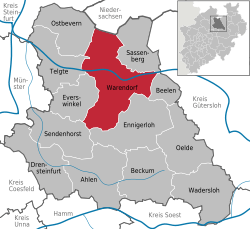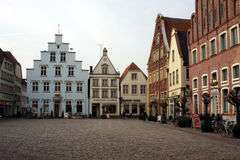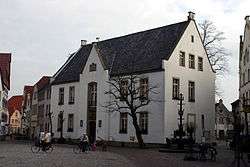Warendorf
| Warendorf | ||
|---|---|---|
|
Townhall in Warendorf | ||
| ||
 Warendorf | ||
Location of Warendorf within Warendorf district  | ||
| Coordinates: 51°57′14″N 7°59′36″E / 51.95389°N 7.99333°ECoordinates: 51°57′14″N 7°59′36″E / 51.95389°N 7.99333°E | ||
| Country | Germany | |
| State | North Rhine-Westphalia | |
| Admin. region | Münster | |
| District | Warendorf | |
| Government | ||
| • Mayor | Axel Linke (CDU) | |
| Area | ||
| • Total | 176.75 km2 (68.24 sq mi) | |
| Elevation | 57 m (187 ft) | |
| Population (2015-12-31)[1] | ||
| • Total | 37,249 | |
| • Density | 210/km2 (550/sq mi) | |
| Time zone | CET/CEST (UTC+1/+2) | |
| Postal codes | 48231 | |
| Dialling codes | 02581 | |
| Vehicle registration | WAF, BE | |
| Website | www.warendorf.de | |
Warendorf is a town in North Rhine-Westphalia, Germany, and capital of Warendorf District.
The town is best known today for its well-preserved medieval town centre, for horse-riding, and the opportunities it provides for cycling. Bicycles are such a common means of transport in the area that many cycle paths have been built, even alongside main roads outside the town.
History
The origin and name Warendorf date back to the ancient Saxon royal court of Warintharpa (“the village on the embankment”), which was most likely already formed in 700 BC. Between the years of 1197 and 1201 Warendorf became a town. During this time, among the already established parish, which belonged to the “old church” (St. Laurentius), a new, second parish with the “new church” (Marienkirche) was formed just west of the town centre. The medieval records of the founding of Warendorf are missing, along with several records and documents in Münster. These were all destroyed during the rule under the Anabaptists. Bishop Hermann II von Katzenelnbogen (Bishop 1173-1202) also contributed to the founding of the town.
In 1224 the first recorded mention of Warendorf as a civitas, which is a civil and municipal community, was made. The wealth of Warendorf grew increasingly and developed more and more into an important trading town, since it is situated favourably between Münster and Oelde. Apart from that Warendorf profited from the production and selling of linen. The wealthy citizens settled on the market square and in the streets, Emsstrasse and Oststrasse. Still today these areas of the town are most prominent in the townscape of Warendorf. In contrast, the poorer part of population lived in simple houses with dirt floors. These bad living conditions lead to the epidemics and illnesses.
In 1404 there was a great fire in Warendorf, during which along with 600 houses also the “old church” (St. Laurentius) and the town hall with all its inventory were destroyed.
In 1533 the Anabaptist movement spread in Warendorf and also in Münster. This movement took over rule in the town for one week in October 1534, until it was ended by a short occupation by Bishop Franz von Waldeck. Four Anabaptist apostles and the Warendorf Anabaptist movement leaders were sentenced to death and were executed by a sword on the market square. As a deterrent the bodies of the “apostles” were laid on the four gates into the town. As a result of this, Warendorf lost its town rights and regained them again in 1542. Free elections of the local council were first held in 1556 under Bishop Franz von Waldeck's successor. The Anabaptist movement continued up into the 17th century in the background without any serious danger for the town or church.[2][3]
Between 1627 and 1632 loss of the town rights occurred during religious battles of the Thirty Years' War. The first mention of the “Fettmarkt” dates back to 1657. This event remained an important funfair with a flea market and livestock market still today. In 1741 another great fire broke out, which resulted in the destruction of the “new church” (Marienkirche) and 332 houses. Because many tradesmen had to move further, and so Warendorf suffered economic loss.
In 1802 Warendorf came under the Prussian sovereignty. The once blossoming town impoverished. In 1826 the establishment of the Westphalian state stud farm in Warendorf was succeeded by the Prussian stud administration. In 1887 the railroad line Münster – Warendorf – Rheda-Wiedenbrück was opened. In 1937 barracks were built just north of Warendorf. Today, the sport school of the German army is also located in these barracks. On 1 January 1975, a reformation of the municipalities was carried out. This reformation integrated the communities of Einen and Milte, and the town of Freckenhorst into the town of Warendorf. Also during this reformation, the larger district of Warendorf (district) was formed by combining the districts of Warendorf and Beckum. Warendorf became seat of the district government.
Geography
Warendorf is situated on the Ems river in the eastern part of the Münsterland area. This area of the Westphalian Lowland is characterized by agriculture. Because of its varying landscape of fields, pastures, small forests and hedgerows, people compare this area to a park.
The closest large city is Münster, which is located 30 kilometres (19 miles) west of Warendorf. Other large cities in the area are Osnabrück, approx. 40 kilometres (25 miles) to the north, Bielefeld, approx. 45 kilometres (28 miles) to the east, and Hamm, approx. 35 kilometres (22 miles) to the south.


Component localities
Warendorf consists of 6 component localities:
- Warendorf
- Einen
- Müssingen
- Freckenhorst
- Hoetmar
- Milte
Arts and culture
Warendorf has hosted several international events, such as the world skydiving championships, riding events, and the national swimming championships. A notable annual event in Warendorf is the celebration on 15 August of the Feast of the Assumption of the Blessed Virgin Mary (Mariä Himmelfahrt).
Sports
North Rhine-Westphalia's "Landgestüt" (stud farm) and the National Olympic Committee for horse-riding are both located in Warendorf.
The Bundeswehr Sports School, the German armed forces physical education center, is also located in Warendorf.
Education
Notable persons
- One of Warendorf's most famous residents was Paul Spiegel (1937-2006), the former president of the Central Council of Jews in Germany.
- Elisabeth Grümmer (1911-1986), sprano, died in Warendorf
- Bernhard Sprengel (1899-1985), chocolate manufacturer and art patron (Sprengel Museum, Hannover)
- Andreas Ridder (born 1964), football player
- Klaus Welle (born 1964), General secretary of the EU Parliament
- Maximilian Schulze Niehues (born 1988), football player
Twin towns
Warendorf is twinned with:
 Petersfield, United Kingdom[4]
Petersfield, United Kingdom[4] Barentin, France
Barentin, France Oleśnica, Poland
Oleśnica, Poland Navaro, Italy
Navaro, Italy
Neighbouring communities
References
- ↑ "Amtliche Bevölkerungszahlen". Landesbetrieb Information und Technik NRW (in German). 18 July 2016.
- ↑ Hans-Joachim Behr, Die Stadt Warendorf in der Territorialgeschichte des Fürstbistums Münster bis 1803, in: Geschichte der Stadt Warendorf – Band 1., Ardey-Verlag, Münster 2000, ISBN 3-87023-179-3, Seiten 304–308
- ↑ Alois Schröer, Die Kirche von Warendorf zur Zeit der Reformation und der katholischen Erneuerung (1500–1650)., in: Geschichte der Stadt Warendorf – Band 1., Ardey-Verlag, Münster 2000, ISBN 3-87023-179-3, Seiten 351–358
- ↑ Chapman, Phil (May 2006). "Petersfield Twinning Association". Hampshire County Council. Retrieved 2013-07-25.
External links
| Wikimedia Commons has media related to Warendorf. |
- Official site (in German)
- Tourist information


